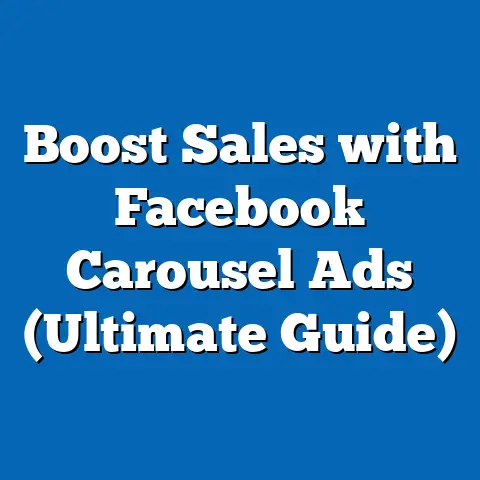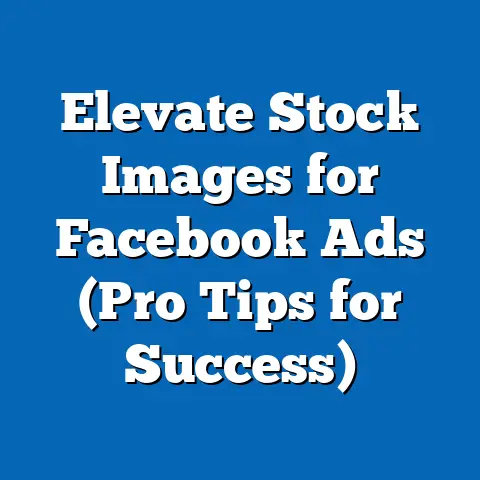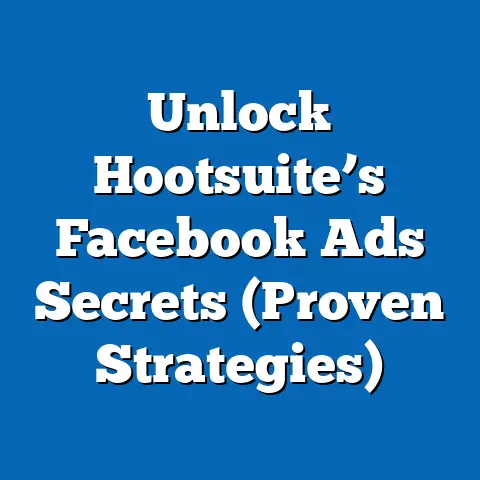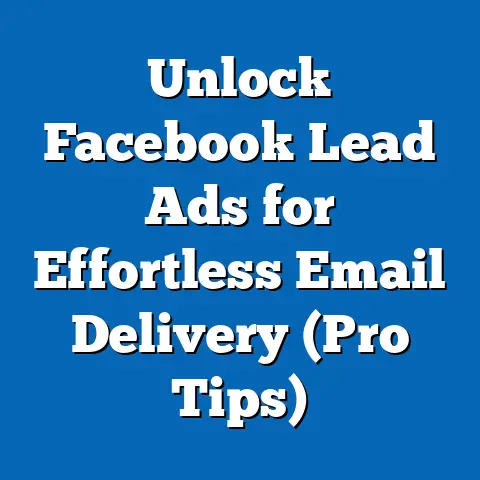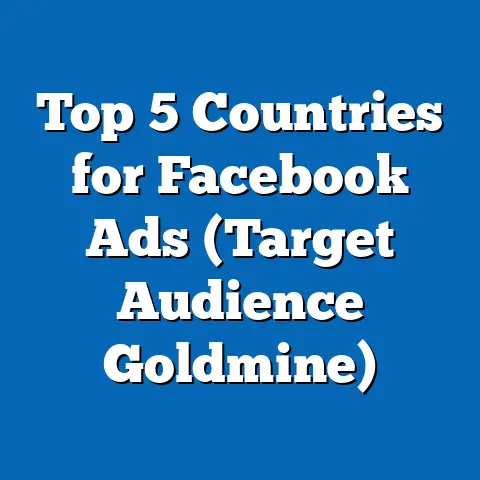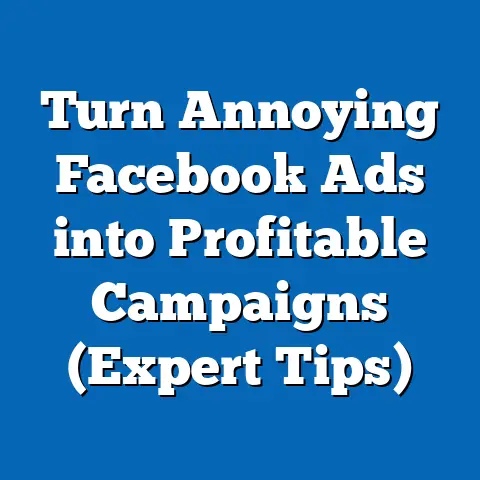Shop Incognito on Facebook (Stealthy Strategies Revealed)
I remember when I first started paying attention to the brands I was buying from. It wasn’t just about the product itself anymore; it was about their values, their impact on the planet, and their ethical practices. This shift in my own thinking mirrors a larger trend in the marketplace: consumers are increasingly demanding more from the companies they support. We want sustainability, transparency, and a commitment to a better world. But navigating the world of online advertising, especially on a platform like Facebook, can feel like walking through a minefield of targeted ads and personalized recommendations. That’s where the concept of “shopping incognito” comes in, and I’m excited to share how you can leverage Facebook’s advertising system while maintaining a focus on eco-friendly products, all while keeping your personal preferences private.
In this article, I’m diving deep into the world of eco-conscious shopping on Facebook, but with a twist. We’re going to explore how to do it “incognito,” meaning how to make mindful purchases without the pressure of social validation or the constant barrage of ads that might not align with your values. I’ll share the strategies I’ve learned over the years, from tweaking privacy settings to leveraging hidden communities, all designed to empower you to shop sustainably without sacrificing your privacy.
This isn’t just about buying “green” products; it’s about making informed choices that reflect your commitment to a better world. So, let’s get started on this journey of stealthy, sustainable, and satisfying shopping!
Understanding the Facebook Marketplace and Advertising Ecosystem
Facebook, in its essence, is a giant social network, but it has evolved into a multifaceted platform with significant e-commerce capabilities. The Facebook Marketplace and its sophisticated advertising system are crucial to understand if you want to shop incognito while still finding eco-friendly products.
How Facebook’s Advertising Platform Works
Facebook’s advertising platform is a complex machine that uses vast amounts of user data to target ads with incredible precision. Here’s a breakdown of how it works:
- Data Collection: Facebook collects data from various sources, including user profiles, activity on the platform (likes, shares, comments), browsing history (through the Facebook Pixel), and even offline activity (if connected through partnerships with data brokers).
- Targeting Options: Advertisers can target users based on demographics (age, gender, location), interests (hobbies, pages liked), behaviors (purchase history, online activity), and even custom audiences (lists uploaded by the advertiser).
- Ad Placements: Ads can appear in various places, including the news feed, right column, Marketplace, Instagram, Audience Network (third-party apps and websites), and Messenger.
- Bidding System: Advertisers bid for ad placements, and Facebook’s algorithm determines which ads to show based on factors like bid amount, ad quality, and relevance to the user.
This intricate system means that every interaction you have on Facebook—every like, every search, every page you visit—contributes to the profile that advertisers use to target you. This is why understanding how to control your data and preferences is crucial for shopping incognito.
The Significance of the Facebook Marketplace
The Facebook Marketplace has become a significant player in the e-commerce world, particularly for smaller businesses and individuals. It’s a place where you can buy and sell everything from furniture to clothing to handmade goods. For eco-conscious consumers, the Marketplace offers several advantages:
- Local and Sustainable Options: You can often find local sellers offering sustainable products, reducing the carbon footprint associated with shipping.
- Secondhand and Upcycled Goods: The Marketplace is a great place to find secondhand and upcycled items, giving new life to products that might otherwise end up in landfills.
- Direct Connection with Sellers: You can communicate directly with sellers, asking questions about their products and their sustainability practices.
The Growth of E-commerce on Facebook
E-commerce on Facebook has experienced significant growth in recent years, particularly in eco-friendly niches. According to Statista, social commerce is projected to reach \$1.2 trillion globally by 2025, with Facebook playing a significant role in this growth. I’ve noticed this myself, as more and more sustainable brands are using Facebook to reach their target audience.
The rise of eco-conscious e-commerce is driven by increasing consumer awareness of environmental issues and a desire to support businesses that align with their values. Facebook, with its vast user base and sophisticated advertising capabilities, is a natural platform for these brands to connect with their customers.
Advantages of Shopping Incognito on Facebook
Shopping incognito on Facebook offers several key advantages:
- Privacy: You can browse and purchase products without revealing your interests to everyone on your friends list.
- Personalized Experiences: By carefully curating your ad preferences, you can receive targeted ads for eco-friendly products that genuinely interest you.
- Discovering Unique Sustainable Products: Shopping incognito allows you to explore niche communities and groups where you can find unique, handcrafted, and sustainable products that you might not discover through mainstream advertising.
- Avoiding Impulse Buys: By reducing the constant bombardment of irrelevant ads, you can make more thoughtful and intentional purchasing decisions.
Key Takeaway: Understanding how Facebook’s advertising ecosystem works and recognizing the potential of the Marketplace are the first steps toward shopping incognito. By taking control of your data and preferences, you can create a more personalized and sustainable shopping experience.
The Psychology of Stealthy Shopping
Shopping, in general, is a complex behavior driven by a multitude of factors, including needs, desires, social influences, and psychological triggers. When we add the element of “stealth,” it introduces an interesting layer of motivations. In the context of eco-conscious shopping on Facebook, understanding these psychological factors can help us navigate the platform more effectively and make more mindful choices.
Psychological Factors Driving Stealthy Shopping
- Fear of Judgment: One of the primary drivers of stealthy shopping is the fear of judgment. People may feel self-conscious about their purchasing habits, especially if they deviate from social norms or expectations. For example, someone might be hesitant to publicly express interest in sustainable products if their friends and family are not equally eco-conscious.
- Social Pressure: Social media platforms like Facebook can amplify social pressure, making people feel compelled to conform to certain trends or lifestyles. Stealthy shopping allows individuals to explore their interests without feeling pressured to share them publicly.
- Privacy Concerns: In an era of increasing data breaches and privacy violations, many people are becoming more cautious about sharing their personal information online. Stealthy shopping provides a way to protect your privacy while still engaging in e-commerce activities.
- Desire for Autonomy: Some people simply prefer to make their own choices without external influence. Stealthy shopping allows individuals to maintain control over their purchasing decisions, free from the opinions and recommendations of others.
Aligning with Eco-Conscious Values
Stealthy shopping aligns particularly well with eco-conscious values. Here’s why:
- Thoughtful Purchases: Eco-conscious consumers are often more deliberate in their purchasing decisions, taking the time to research products and consider their environmental impact. Stealthy shopping allows them to do this without being swayed by impulse buys or marketing hype.
- Avoiding Greenwashing: Greenwashing is the practice of deceptively marketing products as environmentally friendly when they are not. By shopping incognito, consumers can avoid being targeted by misleading ads and make more informed choices based on their own research.
- Supporting Niche Brands: Eco-conscious consumers often seek out smaller, independent brands that prioritize sustainability. Stealthy shopping allows them to discover these brands without being limited to the products promoted by mainstream advertisers.
- Reducing Consumption: Ultimately, eco-consciousness is about reducing overall consumption and minimizing waste. Stealthy shopping can help individuals avoid unnecessary purchases and focus on buying only what they truly need and value.
Impact of Social Media on Consumer Buying Habits
Social media has a profound impact on consumer buying habits, particularly in terms of sustainability and ethical consumption. On one hand, social media can raise awareness of environmental issues and promote eco-friendly products. On the other hand, it can also contribute to consumerism and promote unsustainable lifestyles.
- Influence of Influencers: Social media influencers can play a significant role in shaping consumer attitudes towards sustainability. When influencers promote eco-friendly products, they can inspire their followers to adopt more sustainable practices.
- Viral Trends: Social media trends can drive demand for certain products, both sustainable and unsustainable. For example, a viral trend promoting reusable water bottles can lead to increased sales and reduced plastic waste.
- Social Validation: Social media can also create a sense of social validation, where people feel compelled to purchase certain products in order to fit in or gain approval from their peers. This can lead to impulse buys and unsustainable consumption patterns.
Key Takeaway: By understanding the psychological factors that drive stealthy shopping and the impact of social media on consumer buying habits, you can navigate Facebook more effectively and make more mindful choices that align with your eco-conscious values.
Strategies for Shopping Incognito on Facebook
Now let’s get into the practical strategies I use to maintain a stealthy presence while pursuing eco-friendly finds on Facebook. These tactics focus on maximizing privacy, engaging with relevant communities, and leveraging Facebook’s ad preferences to tailor your experience.
Utilizing Privacy Settings
One of the most fundamental steps in shopping incognito on Facebook is to adjust your privacy settings. These settings control who can see your posts, your activity, and your personal information.
Step-by-Step Guide to Adjusting Privacy Settings:
- Access Privacy Settings:
- Click the downward-facing arrow in the top-right corner of Facebook.
- Select “Settings & Privacy,” then click “Settings.”
- In the left-hand menu, click “Privacy.”
- Control Who Can See Your Posts:
- Under “Your Activity,” find “Who can see your future posts?”
- Click “Edit” and choose “Friends,” “Only Me,” or “Custom.”
- Selecting “Only Me” ensures that your posts are only visible to you.
- Limit Past Posts:
- Find “Limit the audience for posts you’ve shared with friends of friends or Public?”
- Click “Limit Past Posts.” This will change the audience of your past public posts to “Friends.”
- Control Who Can See Your Friends List:
- Under “How People Find and Contact You,” find “Who can see your friends list?”
- Click “Edit” and choose “Only Me” to prevent others from seeing your connections.
- Control How People Can Find You:
- Under “How People Find and Contact You,” find “Who can look you up using the email address you provided?” and “Who can look you up using the phone number you provided?”
- Set these options to “Friends” or “Only Me” to limit who can find you using your contact information.
- Control Whether Search Engines Can Link to Your Profile:
- Find “Do you want search engines outside of Facebook to link to your profile?”
- Uncheck the box to prevent search engines from indexing your profile.
- Click the downward-facing arrow in the top-right corner of Facebook.
- Select “Settings & Privacy,” then click “Settings.”
- In the left-hand menu, click “Privacy.”
- Under “Your Activity,” find “Who can see your future posts?”
- Click “Edit” and choose “Friends,” “Only Me,” or “Custom.”
- Selecting “Only Me” ensures that your posts are only visible to you.
- Find “Limit the audience for posts you’ve shared with friends of friends or Public?”
- Click “Limit Past Posts.” This will change the audience of your past public posts to “Friends.”
- Under “How People Find and Contact You,” find “Who can see your friends list?”
- Click “Edit” and choose “Only Me” to prevent others from seeing your connections.
- Under “How People Find and Contact You,” find “Who can look you up using the email address you provided?” and “Who can look you up using the phone number you provided?”
- Set these options to “Friends” or “Only Me” to limit who can find you using your contact information.
- Find “Do you want search engines outside of Facebook to link to your profile?”
- Uncheck the box to prevent search engines from indexing your profile.
Importance of Controlling Visibility:
Controlling who sees your posts and activity on Facebook is crucial for maintaining a stealthy shopping experience. By limiting your visibility, you can prevent your friends and family from seeing your interests and purchasing habits. This can help you avoid unwanted judgment or social pressure. I’ve personally found this incredibly useful when exploring new interests or hobbies without feeling like I need to justify them to anyone.
Engaging with Eco-Friendly Brands
Engaging with eco-friendly brands on Facebook is a great way to discover new products and support sustainable businesses. However, if you want to shop incognito, you need to be strategic about how you interact with these brands.
Tips for Discovering and Engaging with Eco-Friendly Brands:
- Use the Search Function:
- Use the Facebook search bar to find eco-friendly brands, products, or related keywords (e.g., “sustainable clothing,” “organic skincare,” “eco-friendly home goods”).
- Look for brands that align with your values and offer products that you genuinely need.
- Follow Brands Privately:
- Instead of liking a brand’s page publicly, you can follow them privately. This allows you to see their posts in your news feed without alerting your friends.
- To follow a brand privately, visit their page and click the “Following” button. Then, choose “See First” to prioritize their posts in your news feed.
- Interact Through Direct Messages:
- Instead of commenting publicly on a brand’s posts, consider reaching out to them through direct messages. This allows you to ask questions, provide feedback, or request information without revealing your interest to others.
- Save Posts for Later:
- If you find a post about an eco-friendly product that interests you, save it for later instead of liking or sharing it. This allows you to revisit the post at your convenience without drawing attention to it.
- Use the Facebook search bar to find eco-friendly brands, products, or related keywords (e.g., “sustainable clothing,” “organic skincare,” “eco-friendly home goods”).
- Look for brands that align with your values and offer products that you genuinely need.
- Instead of liking a brand’s page publicly, you can follow them privately. This allows you to see their posts in your news feed without alerting your friends.
- To follow a brand privately, visit their page and click the “Following” button. Then, choose “See First” to prioritize their posts in your news feed.
- Instead of commenting publicly on a brand’s posts, consider reaching out to them through direct messages. This allows you to ask questions, provide feedback, or request information without revealing your interest to others.
- If you find a post about an eco-friendly product that interests you, save it for later instead of liking or sharing it. This allows you to revisit the post at your convenience without drawing attention to it.
Benefits of Following Brands Privately:
- Personalized News Feed: By following eco-friendly brands privately, you can curate a news feed that is tailored to your interests, without being bombarded by irrelevant ads or posts.
- Exclusive Offers: Many brands offer exclusive discounts and promotions to their followers. By following brands privately, you can take advantage of these offers without alerting your friends.
- Direct Communication: Following brands privately allows you to communicate directly with them through direct messages, which can be helpful if you have questions or need support.
Leveraging Facebook Groups and Communities
Facebook groups and communities are a great way to connect with like-minded individuals and discover new eco-friendly products. However, if you want to participate in these groups incognito, you need to be mindful of your privacy.
How to Find and Join Eco-Conscious Facebook Groups:
- Use the Search Function:
- Use the Facebook search bar to find eco-conscious groups, communities, or related keywords (e.g., “sustainable living,” “zero waste,” “eco-friendly products”).
- Look for groups that align with your values and have active members.
- Join Groups Privately:
- When you request to join a group, choose the option to keep your membership private. This prevents your friends from seeing that you have joined the group.
- To do this, click the “Join Group” button and select “Only Me” under “Who can see that you’re a member?”
- Create a Separate Account:
- Consider creating a separate Facebook account specifically for participating in eco-conscious groups. This allows you to keep your personal and professional lives separate.
- Use the Facebook search bar to find eco-conscious groups, communities, or related keywords (e.g., “sustainable living,” “zero waste,” “eco-friendly products”).
- Look for groups that align with your values and have active members.
- When you request to join a group, choose the option to keep your membership private. This prevents your friends from seeing that you have joined the group.
- To do this, click the “Join Group” button and select “Only Me” under “Who can see that you’re a member?”
- Consider creating a separate Facebook account specifically for participating in eco-conscious groups. This allows you to keep your personal and professional lives separate.
Ways to Participate in Discussions and Gather Recommendations Stealthily:
- Use a Pseudonym:
- If you are concerned about privacy, consider using a pseudonym when participating in group discussions. This allows you to share your thoughts and opinions without revealing your real name.
- Avoid Sharing Personal Information:
- Be cautious about sharing personal information in group discussions, such as your location, occupation, or contact details. This can help you protect your privacy and avoid unwanted attention.
- Ask Questions Without Revealing Your Intentions:
- When asking questions about eco-friendly products, avoid revealing your specific intentions. For example, instead of asking “Where can I buy sustainable clothing?” ask “What are some good brands for eco-friendly fashion?”
- Gather Recommendations Through Direct Messages:
- If you want to gather recommendations for eco-friendly products, consider reaching out to group members through direct messages. This allows you to have private conversations without revealing your interest to the entire group.
- If you are concerned about privacy, consider using a pseudonym when participating in group discussions. This allows you to share your thoughts and opinions without revealing your real name.
- Be cautious about sharing personal information in group discussions, such as your location, occupation, or contact details. This can help you protect your privacy and avoid unwanted attention.
- When asking questions about eco-friendly products, avoid revealing your specific intentions. For example, instead of asking “Where can I buy sustainable clothing?” ask “What are some good brands for eco-friendly fashion?”
- If you want to gather recommendations for eco-friendly products, consider reaching out to group members through direct messages. This allows you to have private conversations without revealing your interest to the entire group.
Using Facebook’s Ad Preferences
Facebook’s ad preferences allow you to customize the types of ads you see on the platform. By carefully curating your ad preferences, you can receive targeted ads for eco-friendly products that genuinely interest you.
Insights on Customizing Ad Preferences:
- Access Ad Preferences:
- Click the downward-facing arrow in the top-right corner of Facebook.
- Select “Settings & Privacy,” then click “Settings.”
- In the left-hand menu, click “Ads.”
- Review and Update Your Interests:
- Under “Interests,” review the categories and subcategories that Facebook has assigned to you.
- Remove any categories that are not relevant to your interests.
- Add new categories that align with your eco-conscious values (e.g., “sustainable living,” “organic food,” “renewable energy”).
- Review and Update Your Advertisers:
- Under “Advertisers,” review the list of advertisers that have shown you ads on Facebook.
- Remove any advertisers that are not relevant to your interests.
- Add new advertisers that offer eco-friendly products or services.
- Review and Update Your Ad Settings:
- Under “Ad Settings,” review the settings related to your data, such as your relationship status, education, and job title.
- Update these settings to ensure that they accurately reflect your interests and values.
- Click the downward-facing arrow in the top-right corner of Facebook.
- Select “Settings & Privacy,” then click “Settings.”
- In the left-hand menu, click “Ads.”
- Under “Interests,” review the categories and subcategories that Facebook has assigned to you.
- Remove any categories that are not relevant to your interests.
- Add new categories that align with your eco-conscious values (e.g., “sustainable living,” “organic food,” “renewable energy”).
- Under “Advertisers,” review the list of advertisers that have shown you ads on Facebook.
- Remove any advertisers that are not relevant to your interests.
- Add new advertisers that offer eco-friendly products or services.
- Under “Ad Settings,” review the settings related to your data, such as your relationship status, education, and job title.
- Update these settings to ensure that they accurately reflect your interests and values.
Importance of Feedback on Ads:
Providing feedback on ads is crucial for refining your shopping experience on Facebook. When you see an ad that is not relevant to your interests, click the “…” icon in the top-right corner of the ad and choose “Hide Ad.” This tells Facebook that you are not interested in the ad and helps the algorithm to show you more relevant ads in the future.
Key Takeaway: By utilizing privacy settings, engaging with eco-friendly brands strategically, leveraging Facebook groups and communities, and customizing your ad preferences, you can shop incognito on Facebook while still discovering new products and supporting sustainable businesses.
Case Studies of Successful Eco-Conscious Brands on Facebook
To further illustrate how eco-conscious brands can effectively utilize Facebook’s advertising tools, let’s delve into a few case studies. These examples will highlight successful strategies, including targeting, ad creatives, and customer engagement tactics, and provide lessons that can inform your own stealthy shopping practices.
Case Study 1: Patagonia
Overview: Patagonia is a well-known outdoor clothing and gear company that has a strong commitment to environmental sustainability. They use Facebook to promote their products, share their environmental initiatives, and engage with their community.
Strategies:
- Targeting: Patagonia targets users who are interested in outdoor activities, environmental conservation, and sustainable living. They also use custom audiences to target existing customers and website visitors.
- Ad Creatives: Patagonia’s ads often feature stunning visuals of outdoor landscapes and people enjoying nature. They also highlight the company’s commitment to sustainability and ethical manufacturing practices.
- Customer Engagement: Patagonia uses Facebook to share stories about their environmental initiatives, such as their Worn Wear program (which encourages customers to repair and reuse their clothing) and their support for environmental organizations. They also engage with their community by responding to comments and messages.
Results:
- Increased brand awareness and loyalty.
- Drove traffic to their website and online store.
- Generated leads for their email marketing campaigns.
Lessons Learned:
- Authenticity is key. Patagonia’s commitment to sustainability is genuine, and this resonates with their target audience.
- Visual storytelling is powerful. Their ads feature stunning visuals that capture the beauty of nature and the spirit of adventure.
- Community engagement is essential. They actively engage with their community by sharing stories, responding to comments, and supporting environmental causes.
Case Study 2: Package Free Shop
Overview: Package Free Shop is a zero-waste store that offers a wide range of sustainable products for the home, personal care, and on-the-go living. They use Facebook to promote their products, educate their audience about zero-waste living, and build a community of like-minded individuals.
Strategies:
- Targeting: Package Free Shop targets users who are interested in zero-waste living, sustainability, and environmental conservation. They also use custom audiences to target existing customers and website visitors.
- Ad Creatives: Package Free Shop’s ads often feature images and videos of their products in action. They also highlight the benefits of zero-waste living, such as reducing waste, saving money, and protecting the environment.
- Customer Engagement: Package Free Shop uses Facebook to share tips and advice on zero-waste living, answer customer questions, and host live Q&A sessions with their founder, Lauren Singer. They also encourage their community to share their own zero-waste tips and experiences.
Results:
- Increased brand awareness and sales.
- Educated their audience about zero-waste living.
- Built a strong community of like-minded individuals.
Lessons Learned:
- Education is important. Package Free Shop uses Facebook to educate their audience about the benefits of zero-waste living and how to get started.
- Visual demonstrations are effective. Their ads feature images and videos of their products in action, which helps customers visualize how they can use them in their own lives.
- Community building is essential. They actively engage with their community by answering questions, hosting live events, and encouraging customers to share their own experiences.
Case Study 3: TenTree
Overview: TenTree is an apparel company that plants ten trees for every item purchased. They use Facebook to promote their products, share their reforestation efforts, and engage with their community.
Strategies:
- Targeting: TenTree targets users who are interested in sustainable fashion, environmental conservation, and outdoor activities. They also use custom audiences to target existing customers and website visitors.
- Ad Creatives: TenTree’s ads often feature images of their clothing being worn in beautiful outdoor settings. They also highlight the company’s commitment to planting trees and supporting reforestation projects.
- Customer Engagement: TenTree uses Facebook to share updates on their reforestation efforts, showcase the impact of their tree-planting projects, and engage with their community by responding to comments and messages.
Results:
- Increased brand awareness and sales.
- Raised awareness of the importance of reforestation.
- Built a strong community of environmentally conscious consumers.
Lessons Learned:
- Transparency is key. TenTree is transparent about their tree-planting efforts and shares updates on their progress with their community.
- Impact storytelling is powerful. They showcase the impact of their tree-planting projects by sharing stories and visuals from the field.
- Mission-driven marketing is effective. Their commitment to planting trees resonates with their target audience and drives customer loyalty.
Key Takeaway: These case studies demonstrate that eco-conscious brands can successfully utilize Facebook’s advertising tools to promote their products, educate their audience, and build a community of like-minded individuals. By focusing on authenticity, visual storytelling, customer engagement, and mission-driven marketing, these brands have been able to achieve significant results on Facebook.
The Future of Eco-Conscious Shopping on Facebook
The world is constantly evolving, and so is the landscape of e-commerce and social media. As eco-consciousness continues to grow in importance, it’s essential to consider how these trends will shape the future of shopping on Facebook.
Emerging Trends in Eco-Consciousness
- Circular Economy: The circular economy is a model of production and consumption that involves sharing, leasing, reusing, repairing, refurbishing, and recycling existing materials and products for as long as possible. This trend is gaining traction as consumers become more aware of the environmental impact of linear “take-make-dispose” models.
- Regenerative Agriculture: Regenerative agriculture is a system of farming principles and practices that seeks to rehabilitate and enhance ecosystems. This trend is driven by a growing awareness of the importance of soil health, biodiversity, and carbon sequestration.
- Sustainable Packaging: Sustainable packaging is packaging that is designed to minimize its environmental impact. This trend is driven by increasing consumer concern about plastic waste and the need for more eco-friendly packaging solutions.
- Ethical Consumption: Ethical consumption is the practice of purchasing products that are made in a way that respects human rights and the environment. This trend is driven by a growing awareness of social and environmental issues, such as labor exploitation and deforestation.
Potential Changes to Facebook’s Advertising Algorithms and Privacy Features
As consumer attitudes towards privacy and sustainability evolve, Facebook may need to adapt its advertising algorithms and privacy features to meet these changing expectations.
- Enhanced Privacy Controls: Facebook could introduce more granular privacy controls that allow users to specify which types of data they are willing to share with advertisers.
- Transparency Tools: Facebook could provide users with more transparency tools that allow them to see how their data is being used for advertising purposes.
- Sustainability Metrics: Facebook could incorporate sustainability metrics into its advertising platform, allowing advertisers to track the environmental impact of their campaigns.
- Community-Driven Initiatives: Facebook could support community-driven initiatives that promote eco-conscious shopping, such as groups, forums, and marketplaces.
Role of Community-Driven Initiatives and Collaborations
Community-driven initiatives and collaborations among eco-friendly brands could play a significant role in shaping the future of eco-conscious shopping on Facebook.
- Collaborative Marketing Campaigns: Eco-friendly brands could partner with each other to create collaborative marketing campaigns that promote their products and services to a wider audience.
- Cross-Promotional Activities: Eco-friendly brands could engage in cross-promotional activities, such as featuring each other’s products in their ads or offering discounts to each other’s customers.
- Joint Events and Workshops: Eco-friendly brands could host joint events and workshops that educate consumers about sustainability and promote their products and services.
- Community Building Activities: Eco-friendly brands could work together to build communities of like-minded individuals on Facebook, where they can share tips, advice, and support.
Key Takeaway: The future of eco-conscious shopping on Facebook will be shaped by emerging trends in eco-consciousness, potential changes to Facebook’s advertising algorithms and privacy features, and the role of community-driven initiatives and collaborations among eco-friendly brands. By staying informed about these trends and actively participating in these initiatives, you can help to create a more sustainable and ethical shopping experience on Facebook.
Conclusion
As we’ve explored throughout this article, eco-consciousness is more than just a trend; it’s a fundamental shift in how consumers approach purchasing decisions. The rise of sustainable practices and ethical sourcing reflects a deeper desire to align our actions with our values, and Facebook, as a dominant platform in our digital lives, plays a crucial role in this evolution.
Shopping incognito on Facebook isn’t just about hiding your preferences; it’s about reclaiming your power as a consumer. It’s about making informed choices, supporting brands that align with your values, and resisting the pressures of consumerism. By adopting the stealthy strategies I’ve outlined—adjusting privacy settings, engaging selectively with brands, leveraging communities, and customizing ad preferences—you can navigate the platform in a way that empowers you to shop sustainably without sacrificing your privacy.
I encourage you to take these strategies and adapt them to your own needs and preferences. Experiment with different approaches, explore niche communities, and don’t be afraid to challenge the status quo. Together, we can create a more sustainable and ethical shopping experience on Facebook, one stealthy purchase at a time. So go forth, shop incognito, and make a difference!

